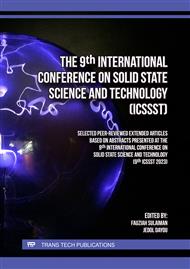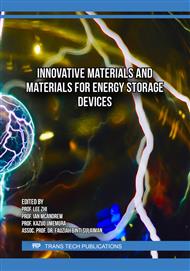[1]
H, Niu., L. Wang, P. Guan, N. Zhang, C. Yan, M. Ding, X. Guo, T. Huang & X. Hu. Recent advances in application of ionic liquids in electrolyte of lithium ion batteries. Journal of energy storage, 40, 102659. (2021).
DOI: 10.1016/j.est.2021.102659
Google Scholar
[2]
M. Yuan, & K. Liu, Rational design on separators and liquid electrolytes for safer lithium-ion batteries. Journal of Energy Chemistry, 43, (2020) 58-70.
DOI: 10.1016/j.jechem.2019.08.008
Google Scholar
[3]
H. Wang, L. Sheng, G. Yasin, L. Wang, H. Xu, & X. He. Reviewing the current status and development of polymer electrolytes for solid-state lithium batteries. Energy Storage Materials, 33 (2020) 188-215.
DOI: 10.1016/j.ensm.2020.08.014
Google Scholar
[4]
S. Rudhziah, M. S. A. Rani, A. Ahmad, N. S. Mohamed and H. Kaddami, H. Potential of blend of kappa carrageenan and cellulose derivatives for green polymer electrolyte application. Industrial Crops and Products, 72 (2015) 133-141.
DOI: 10.1016/j.indcrop.2014.12.051
Google Scholar
[5]
R. Balart, D. Garcia-Garcia, V. Fombuena, L. Quiles-Carillo, & M. P. Arrieta Biopolymers from natural resources. Polymers, 13(15) (2021) 2532.
DOI: 10.3390/polym13152532
Google Scholar
[6]
A. S. Samsudin, and M. A. Saadiah. Ionic conduction study of enhanced amorphous solid bio-polymer electrolytes based carboxymethyl cellulose doped NH4Br. Journal of Non-Crystalline Solids (2018).
DOI: 10.1016/j.jnoncrysol.2018.05.027
Google Scholar
[7]
M. N. Hafiza, and M. I. N. Isa (a). Transport studies of carboxymethyl cellulose/ chitosan-ammonium bromide biopolymer blend electrolytes as an ionic conductor. Journal of Sustainability Science and Management Special Issue Number 2: Fundamental Interdisciplinary Pathways to Future Sustainability (2017) 58-64.
Google Scholar
[8]
R. C. Agrawal, and G. P. Pandey. Solid polymer electrolytes: materials designing and all-solid-state battery applications: an overview. Journal of Physics D: Applied Physics, 41(22) (2008) 223001.
DOI: 10.1088/0022-3727/41/22/223001
Google Scholar
[9]
M. Keller, G. B. Appetecchi, G. T. Kim, V. Sharova, M. Schneider, J. Schuhmacher, and S. Passerini. Electrochemical performance of a solvent-free hybrid ceramic-polymer electrolyte based on Li7La3Zr2O12 in (PEO)15LiTFSI. Journal of Power Sources, 353 (2017) 287-297.
DOI: 10.1016/j.jpowsour.2017.04.014
Google Scholar
[10]
Q. Pan, D. M. Smith, H. Qi, S. Wang, and C.Y. Li. Hybrid electrolytes with controlled network structures for lithium metal batteries. Advanced Materials, 27(39) (2015) 5995-6001.
DOI: 10.1002/adma.201502059
Google Scholar
[11]
M. A. Ramlli, and M. I. N. Isa. Structural and ionic transport properties of protonic conducting solid biopolymer electrolytes based on Carboxymethyl cellulose doped with ammonium fluoride. The Journal of Physical Chemistry B, 120(44) (2016)11567-11573.
DOI: 10.1021/acs.jpcb.6b06068
Google Scholar
[12]
X. Meng, G. C. Yoo, M. Li, and A. J. Ragauskas. Physicochemical structural changes of cellulosic substrates during enzymatic saccharification. Journal of Applied Biotechnology & Bioengineering, 1(3) (2016).
DOI: 10.15406/jabb.2016.01.00015
Google Scholar
[13]
Rarmesh, K.H. Leen, K. Kumutha, A.K. Arof, FTIR studies of PVC/PMMA blend based polymer electrolytes, Spectrochim. Acta A 66 (2007) 1237–1242.
DOI: 10.1016/j.saa.2006.06.012
Google Scholar
[14]
C. Naceur Abouloula, M. Rizwan, V. Selvanathan, C. I. Abdullah, A. Hassan, R. Yahya, and A. Oueriagli. A novel application for oil palm empty fruit bunch : extraction and modification of cellulose for solid polymer electrolyte. Ionics (2018) 1–10.
DOI: 10.1007/s11581-018-2558-7
Google Scholar
[15]
S.N.F. Yusuf, A.D. Azzahari, R. Yahya, S.R. Majid, M.A;. Careem, and A.K. Arof. From crab shell to solar cell: a gel polymer electrolyte based on N-phthaloylchitosan and its application in dye-sensitized solar cells. RSC Adv 6 (2016) 27714–27724.
DOI: 10.1039/c6ra04188d
Google Scholar
[16]
S.T. Hameed, T. F. Qahtan, A. M. Abdelghany, & A. H. Oraby. Effect of zinc oxide nanoparticles on physical properties of carboxymethyl cellulose/poly (ethylene oxide) matrix. Physica B: Condensed Matter, 633 (2022) 413771.
DOI: 10.1016/j.physb.2022.413771
Google Scholar
[17]
M. S. Su'ait, A. Ahmad, K. H. Badri, N. S. Mohamed, M. Y. A. Rahman, C. L. A. Ricardo, and P. Scardi, The potential of polyurethane bio- based solid polymer electrolyte for photoelectrochemical cell application. international journal of hydrogen energy, 39(6) (2014) 3005-3017.
DOI: 10.1016/j.ijhydene.2013.08.117
Google Scholar
[18]
A. S. Samsudin, and M. I. N. Isa. Study of the conduction mechanism based on carboxymethyl cellulose biopolymer electrolytes. Journal of the Korean Physical Society. 65 (9) (2014) 1441 – 1447.
DOI: 10.3938/jkps.65.1441
Google Scholar
[19]
S. U. Patil, S. S. Yawale, and S. P. Yawale. Conductivity study of PEO-LiClO4 polymer electrolyte doped with ZnO nanocomposite ceramic filler. Bulletin of Materials Science, 37(6) (2014) 1403-1409.
DOI: 10.1007/s12034-014-0089-z
Google Scholar



